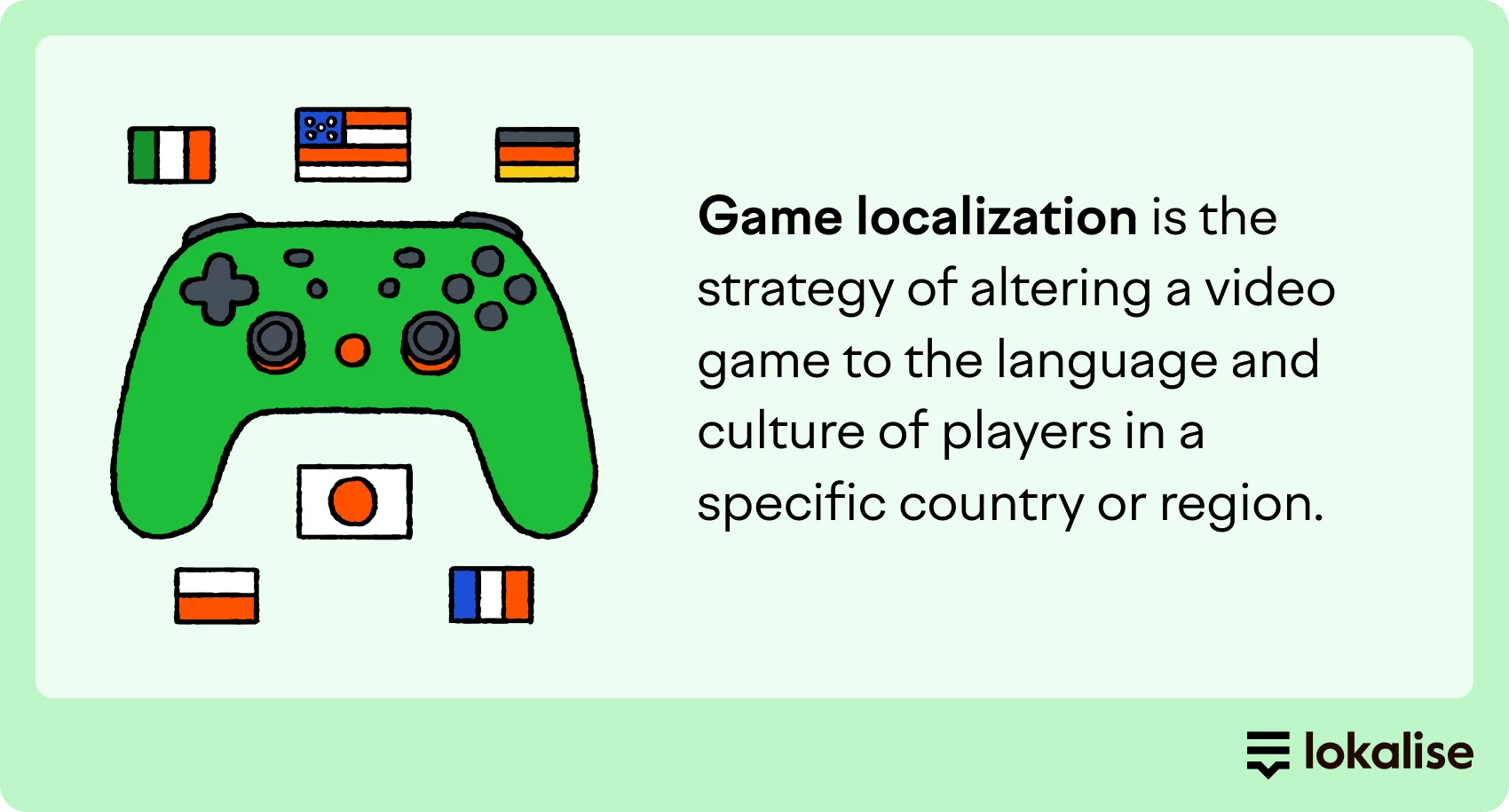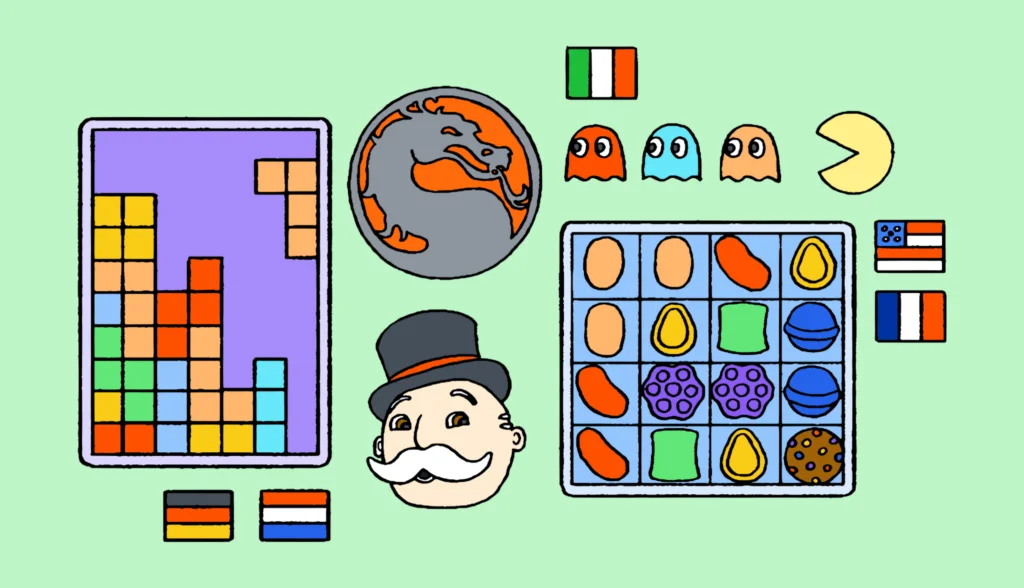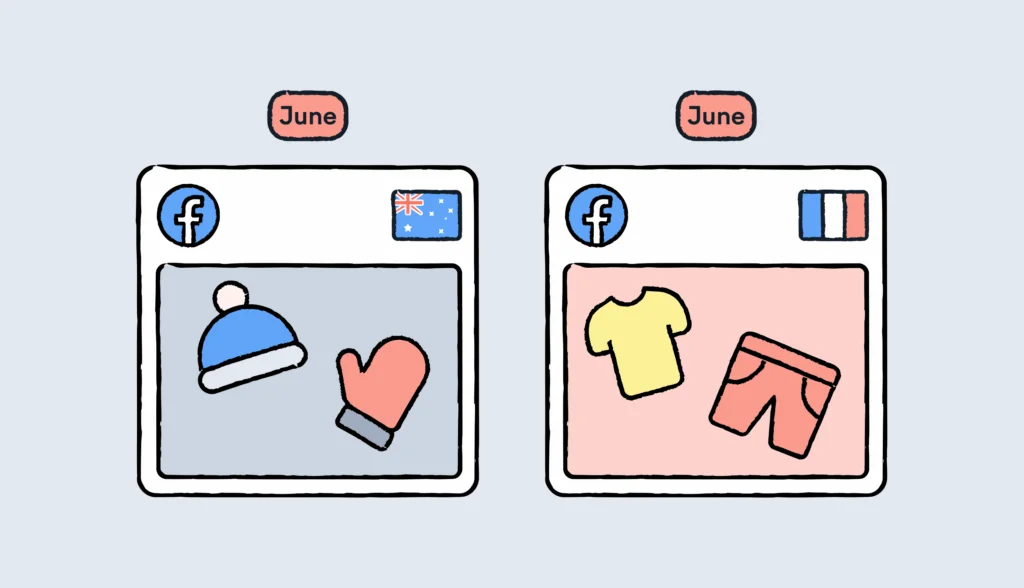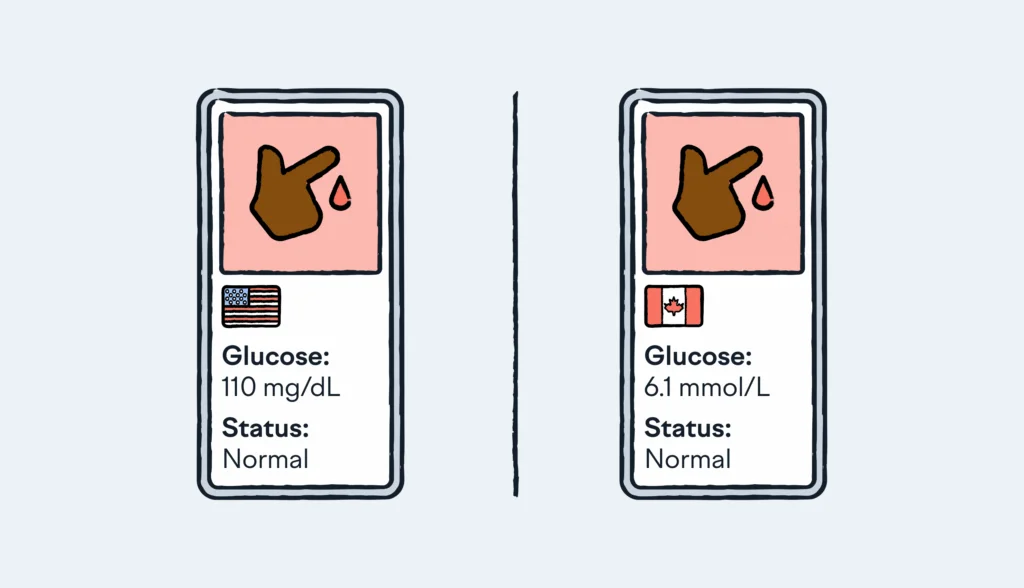If you’re looking to launch your game internationally and engage players around the globe, you have to make the right language and cultural adjustments. That’s what game localization is all about.
Game localization can get quite complex. The development team, project managers, producers, linguists, translators, editors, UX experts – all of them need to work together to properly localize a game. It truly takes a village. Incorporating software internationalization practices early in the development cycle can streamline workflows and minimize potential localization challenges.
In this guide, we break down what game localization is, why it’s important, and how to properly localize your video game to expand to new markets. Plus, we’ll show you exactly how you can leverage Lokalise to simplify the game localization process.
What is game localization?
Game localization is the strategy of altering a video game to the language and culture of players in a specific country or region.

Software localization for video games can include adaptations like:
- Game dialogues and caption translation
- Instruction manual translation
- Character tweaks
- Animation changes
- User interface adaptations
- Marketing asset translation
Game localization vs game translation
Game localization and game translation are not the same. Check out the table below to immediately understand the difference.
| Game translation | Game localization |
| Changing the text or spoken language within the video game | Translation + cultural changes, censorship, and marketing strategy |
Who’s involved in game localization?
Localizing a video game is no easy task. You need to successfully reach players in multiple countries, where cultural references, traditions, and tastes vary. Just one small detail could make your game feel out of place.
When adapting a video game to different groups of people, creators need to ensure a variety of stakeholders are involved in the process:
- Game developers
- Project owners (or producers who oversee the entire project)
- Product managers
- Translators for different target languages
- Localization quality assurance (LQA) specialists
- Editors
- Sound professionals
- UX experts
- Marketing managers
If localization isn’t done right, it could lead to revenue loss, failure to meet launch dates, and a knock to your brand reputation.
Before we dive into the best practices for game localization, let’s take a moment to discuss the value of game localization and look at a few examples.
What are the benefits of video game localization?
The global video game industry is valued at $447 billion. And, by 2032, it’s expected to reach $1 trillion. The landscape is becoming increasingly competitive. Those providers who stay in touch with gamers worldwide and adapt the games to better fit their needs and expectations are ultimately the ones who will increase their market share.

When you’re able to serve the cultural and linguistic needs of different regions, you’ll encourage greater adoption, engagement, and revenue.
Here’s why video game localization is incredibly valuable for game developers:
Make your launch a success
Marketing your video game effectively is an essential part of a successful product launch. A game launch is similar in many ways to a movie release. If you’re not prepared when you begin building up to the launch, your entire effort could fall flat.
You need to establish translation and localization examples when you first start marketing and promoting the initial trailers worldwide. Don’t let this become an afterthought.
By teasing trailers and game announcements in different languages, you’ll be able to garner initial interest (and hype) from gamers who may not purchase games that aren’t in their native language.
Increase global customer acquisition
When you nail down your pre-release and launch with different languages and cultural references, you are more likely to attract customers around the world.
Localizing your game shows prospective customers that you care about them. As a result, your launch will resonate with more people, and it will give your brand reputation a boost.
🦇 Fun fact
For the video game Batman: Arkham Asylum (2009), an unnamed developer worked for a full two years on nothing but Batman’s cape, which resulted in over 700 animations and sounds related to its movement. This is one example of the tremendous dev effort players might not see or recognize.
Localization is quite similar. Nowadays, people expect great gaming experiences. If they don’t notice your localization efforts, it means you’re doing a great job because your game feels native.
More revenue
Did you know that only 32.33% of Steam users list English as their main language?
Inches behind them is Mandarin, making up 32.22% of all Steam users.
Imagine missing out on a third of your potential customer base because you didn’t release your game in Mandarin.
Put it out in Russian, the next-most common, and you’ll reach another 9.3% of Steam users.
Localizing your video game ensures you cast a wider net. More customers means more revenue, plain and simple.
Maintain quality control
One major reason video game localization is important is quality control.
Video game users often create unofficial “language packs” to help other players understand the game. The problem is that these language packs aren’t regulated by the game publisher, so the quality of translation is often poor.
If you don’t ensure there is a high-quality translation of your game built-in natively, someone might make one for you, and it might not be very good. It could lead to a negative impact on your brand reputation.
By proactively localizing your video game, you ensure you maintain the quality of your game.
Game localization examples
In 2017, PUBG: Battlegrounds was released in South Korea and went on to be a global success.
Part of the reason?
Its publisher, Tencent Games, did an amazing job localizing the game.
With 12 different languages and specific marketing campaigns based on different subregions, the video game quickly climbed the charts.
Now, it’s the fifth-best-selling video game of all time.
Here are some other popular examples of game localization:

Pac-Man
Pac-Man was originally called ‘Puck Man’ because the main character resembled a hockey puck, and speakers of Japanese pronounced it as ‘pakuhuman.’ To avoid mispronunciations and confusion in the U.S., they adjusted the name to what we know today.
Nintendo’s proactive approach to pioneering localization is one reason they’ve maintained the highest market share of any video game company, at 59.56%. They know how to create great video games and localize those games well.
Tony Hawk’s Pro Skater
Another example of language localization is Tony Hawk’s Pro Skater. Something to keep in mind: even if a country speaks the same language (like American and British English), there are countless nuances to language and words that don’t cross over.
In the U.K., the name “Tony Hawk’s Pro Skater” had to be changed since “skater” is a term only used for ice skating and it would sound weird in the U.K. market. Instead, they renamed the U.K. version “Tony Hawk’s Skateboarding.”
Crash Bandicoot
One of the most challenging and ambitious aspects of game localization is being sensitive to taste.
Players are much more likely to play a game if it’s designed in a way they’re familiar with. While taste varies, culture can make a difference in the “normal” overall look of the game, the characters, and the scenery.
One example of this is Crash Bandicoot. It was originally created in the U.S., but when it was brought over to Japan for Sony, there was a problem.
Japanese executives at Sony didn’t like the style of the main character, Crash. They didn’t believe it would do as well in Japan. So, the creator asked the American artist behind Crash to change his look to match the Japanese animations better, with influences from manga and anime.

Honor of Kings
Culture is everything. If you get it wrong with your video game, you could end up disappointing, upsetting, or just confusing people.
Local and cultural historical references are significant from region to region and play a large role in how a video game is experienced. For example, Honor of Kings is a multiplayer online battle arena (MOBA) released in China.
When they launched the game in the U.S., they changed the name: the U.S. hasn’t had any monarchies. So, it was renamed “Arena of Valor” in America.
Super Mario Kart
In some cases, video game content may be legal and absolutely fine to show in one country but illegal or unacceptable in another.
To ensure you’re not breaking local laws or stepping afoul of customs, you may need to adapt sensitive content. In some cases, you may be required to completely remove entire elements of your video game.
For example, In Nintendo’s Super Mario Kart, the game had to be altered for the U.S. market.
In the Japanese version of the game, two of the characters, Princess Peach and Bowser, are depicted drinking champagne after winning a race.
However, Nintendo of America has a policy that restricts the use of alcohol since young children play the game. So, the animations in the U.S. version of the game were altered so Bowser and the Princess aren’t drinking the champagne, but waving the bottle around instead.
🎮 Transcreation as a part of game localization
Game localization can mean making alterations to make the game age-appropriate while bearing in mind the language and the culture of the target market. But, it can involve full localization which means transcreating every aspect of the game, doing full voice-overs, and adjusting actual gameplay.
Key game localization challenges
There are a few game localization challenges that can set you back if you’re not careful.

1. Inefficient processes and the lack of context
According to Elizaveta, the most common bottleneck revolves around idle time spent waiting since developers need to answer a lot of questions. Other unexpected problems might also pop up, such as when a translator doesn’t meet a deadline.
The most typical issues include complicated files, tight deadlines, and a lack of context for translation. Elizaveta also shared how the specificity of the projects might require additional creativity:
“There was one interesting case we had recently: my colleague Oleg Komarov was managing the translation of a client’s game from English to Japanese. The game contained lots of puzzles, and some of them were encrypted with a Vigenère cipher, so we had to decrypt the text.
Here’s how we did it: we translated the encrypted text into Japanese, transcribed the Japanese text into Latin characters, and then sent it back to the client for re-encryption.”
2. Not enough time for the LQA phase
Miguel believes that the main bottleneck in game localization is the linguistic quality assurance LQA phase. Very often, LQA takes place at the end of the process, when the pressure for release is high. He explained the consequences this creates in terms of launch dates. If the game roadmap had any delay and somehow ate into the potential buffer that we might have had in our calendar, the LQA phase is shortened, which is a mistake, says Miguel:
“LQA is a crucially important phase where we see the game as our potential players will see it. Cutting corners in this phase is quite dangerous.”
3. Negotiating rates and treating localization as an afterthought
Mette touched upon the difficulty of negotiating rates in game localization, which have been pushed down and down. It’s a challenge to reward the linguists for the truly amazing work they do. But she also pointed out something that all the participants agree upon, and that’s the problem of how the localization process is organized:
“Localization is often an afterthought in the game dev cycle. Unless the client-side team has a dedicated in-house localization team, it’s not always fully understood what is involved in localizing a game.
Sometimes game dev teams think all the creative thinking and development has been completed, but in reality – the linguists have to be creative writers to truly transfer the gaming experience to their own language.
The localization stage is at the end of the game dev cycle and often any time lost earlier in the development is cut from the loc timeline.”
Tips for optimizing your game localization process
So, how do you handle game localization without jeopardizing the release cycles? Where should you begin?
Tip #1: Start game localization at an early stage
If you want to prevent being late to market, you should start localizing earlier. Preferably the localization activities should be integrated into the game development process, says Miguel:
“The internationalization activities should start ASAP, so the code is prepared to handle multiple languages and the fonts can be integrated from the beginning.
Also, giving feedback about culturalization in the ideation phase is a very good best practice as the cost to change something in this phase is not as expensive as when it’s done in the final code.”
Mette agrees with this:
“Development and localization teams should ideally form a partnership very early on. There needs to be a strong, seamless communication process with regular touchpoints.”
Elizaveta shared her experience as well, and highlighted that there are many parts of a game where you can go wrong from the start if you forget about localization.
Agile localization bridges the gap between the developers and the localization team members and it also helps you conserve resources, whether we’re talking about money or time.
In game localization, it makes sense to go another step further and turn to continuous localization, where localized content is always ready for release.
💡Pro tip
Game localization should keep pace with the speed of game development. Continuous localization provides faster translation turnaround times and much-needed velocity so that you can enter multiple markets almost simultaneously.
Tip #2: Use tools that address your specific needs
Now let’s talk about the tools for game localization. What are the ones that can be of most use to you?
Elizaveta shared that her team typically used CAT tools and software such as Lokalise:
“These tools help us preserve the uniformity and structure of the text. For example, they leave in-game tags undisturbed. To speed up and facilitate the process, you can use services that support an API and allow you to quickly export the translated text back into the game.”
A combination of different tools can also be helpful. For instance, Alpha Games combines memoQ and Lokalise, depending on the type of project.
Miguel believes everyone involved in the game localization process can benefit from the following “software trinity”: a solid TMS, an app to track bugs, and Google Suite.
💡Pro tip
When choosing the best tool for game localization, devote enough time to thinking about the bottlenecks and frustrations you want to eliminate. List your challenges before you start comparing the solutions on the market. Finally, book a demo with a product specialist to ask about specific features that can help you move faster without jeopardizing quality
Tip #3: Find a good localization project manager and invest in LQA
Of course, the tool is only as good as its user. The localization project manager is the one who holds the entire game localization process together. Miguel explained to us why the process has to have an appointed localization project manager and we used these insights to create the following table:

Elizaveta shared how INLINGO Games handles the process of game localization:
“First, the text falls into the project manager’s hands. The manager assesses the text and loads it into the CAT tool.
The translator then starts working and asks questions about the text, and the manager serves as a bridge between the client and translator. Once the translator finishes, the editor proofreads the translation.
In the final stage, the manager does a QA check, makes sure all the tags are in place, and reviews the file after exporting it.
It’s highly recommended that you always do linguistic quality assurance (LQA) after the translation is done. It’s an integral part of the workflow for good localization. During testing, you can find cosmetic and contextual bugs that detract from the translation.”
💡Pro tip
For the best quality, you need at least two people working on every piece of text to deliver full TEP (translation, editing, proofreading), while the LQA process has to be carefully planned. If you don’t have in-house resources outsourcing, consider hiring LSPs for bigger projects as they will cover the localization phase and the LQA phase, too.
Step-by-step guide to game localization
Ready to localize your video game?
Follow these steps to ensure you can reach the world with your game.

1. Preparing: Post-gold or simship
When localizing your video game, you need to decide whether you’re going to run a post-gold or simship strategy.
Here’s what these terms mean:
Post-gold
Post-gold means you’re going to launch your video game only in the primary language at first, and then release it in different versions around the world later.
With post-gold, you can work on the project from start to finish. This also gives translators a better understanding of the final look and feel of the video game.
Simship
The second option is simship, which is short for simultaneous shipment. This is where all versions of the game are launched at the same time around the world.
The main benefit here is that you’ll be able to capture the most revenue.
Since games don’t have super long life cycles, if you want to maximize the potential, you want to ship everything at once to leverage the most excitement around the release.
❗Important note
If you aren’t working with reputable translation and localization software, translators have to work piece by piece through the video game without full context. This can lead to translation errors and issues.
2. Identify target regions
One major decision you’ll make here is what regions, countries, and languages you’ll localize your video game in.
For example, localizing to regions that speak Mandarin opens your video game up to a potential 1.13 billion players. If you localize to regions that speak Hindi, that’s another 609 million people.
Finding which markets you should target with localization isn’t a simple process. There are dozens of factors that go into deciding which regions to go after such as:
- How effective other games have been at localizing the region
- How effective the region is at speaking and reading English
- How many content restrictions and how much censorship there is
You need to look at existing data to see which regions make the most sense, as each one will be a business investment and will add even more complication to your video game launch.
3. Analyze your content
Once you’ve determined if you’re going to go the post-gold or simship route, it’s time to analyze your content.
This is where your team will figure out exactly what they need to translate.
You also need to determine what approach to use. For example, will you just need text and subtitles? Or will you need full voiceovers or dubbing?
4. Create a loc-kit
Next, you’ll need to create a loc-kit, or localization kit. This is your translator’s complete guide to your video game, the content, your brand voice, glossary, localization processes, and anything else they’ll need to translate and localize your game.
5. Code your game with localization in mind
Have your dialogue strings and any other player-visible text (like item descriptions or hints) indexed in separate files from the actual game code. Usually it starts in spreadsheets before you can convert it into a JSON file for each language.
Also, make sure your display has space for long words or wordy languages, that it can handle right-to-left and cursive languages (like Arabic), and that your fonts have all the characters and diacritics you need.
❗Important note
If you put text that the player sees into the code itself, you’ll have to change that part of the code for every language.
6. Localize for culture
Have your dialogue strings and any other player-visible text (like item descriptions or hints) indexed in separate files from the aOnce you’ve completed your translation, it’s time to adapt different cultural elements of your game.
Depending on the countries you’re going to launch the game in, you may need to adjust certain types of content or visuals to ensure it provides the best possible experience for each region.
Hopefully, you started thinking about this early, like Miguel advised, and you haven’t written yourself into any culturally inappropriate corners that will be expensive to get out of. You may want to do this before translation, instead, so you aren’t translating content that will be unusable in the target language.ctual game code. Usually it starts in spreadsheets before you can convert it into a JSON file for each language.
7. Translate the content
Once you’ve built your game, you need to export content to your translation management system (TMS), where it can be translated and adapted to local tastes.
In this step, your TMS will merge all of your resource files together into one centralized platform so your translators can easily work on them in parallel with the development cycle. Using a TMS like Lokalise will speed up the process and significantly cut translation costs.
8. Linguistic quality assurance
This is where professional human translators check the work to make sure it’s objectively correct, but also that it follows your style guide and is consistent with the original work — not making a puzzle harder or easier, for example.
Ideally, your translations won’t give the LQA team any trouble, but you need to make time for them to work.
9. Integrate localization into your video game
Once your content is translated from the source language, edited, and checked for quality assurance, it’s time to import it back into each localized version of the game.
From here, all that’s left to do is launch your game worldwide.
Master video game localization with Lokalise
To leverage the time you have at hand, you need to rethink your game localization process. There is no quick fix for enabling fast release cycles, but you can do an in-depth analysis of all the inefficiencies in your existing localization workflow to help speed up your processes.
As we learned from our game localization experts, starting localization activities in parallel with game development through simship makes a lot of sense.
To simplify and streamline the process, you need to rely on a robust translation management system (TMS) like Lokalise.
Lokalise enables you to effortlessly manage translations, tasks, and teams so you can effectively localize your video games for different markets.
If you want to start localizing your video game, start your free 14-day trial with Lokalise.





